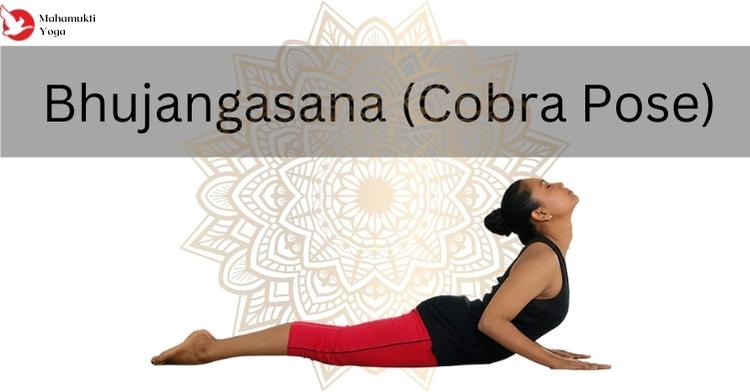Bhujangasana (Cobra Stretch) comes from the word bhujanga which means cobra or snake and asana means pose. Bhujangasana is also known as Cobra Stretch. This pose is included in both Surya namaskar (Sun Salutation Pose) and Padma Sadhana. Want to tone your abs but just can’t find the time to hit the gym. Are you tired or stressed from excessive workload. Bhujangasana or Cobra Stretch is the solution to these and many other problems just sitting or lying down at home.
Bhujangasana, Cobra Pose is a pose you do while lying on your stomach. It gives the body (especially the back) a good stretch that relieves tension almost instantly. Bhujangasana provides many physical and mental health benefits, including release of tension in the back, strengthening of the spine and core, better posture, and improved concentration.
Bhujangasana stretches the strengths on your lower back, upper back and stomach. It helps reduce bad fat around the waist. It is also one of the best yoga asanas to increase height. Traditional scriptures reflect its name that Bhujangasana or the cobra pose increases body heat. When the body heat is released to increase through repeated meditation and yoga practice, it creates a sense of liberation. Its significance can also be seen in images of the Buddha with a cobra placed over his head to represent his enlightened state.
Also Read: Yoga for Flexibility and Strength: Best 5 Poses to Try and Get Healthy
Bhujangasana, or the Cobra Stretch, is one of the most powerful and beneficial poses in yoga. Not only is it beneficial for physical health, but it is beneficial for mental health, as well. Bhujangasana can help to tone and strengthen the spine, increase flexibility, improve posture, and increase core strength. Additionally, this pose can help to reduce stress and tension, improve concentration, and increase body heat.
In traditional scriptures, Bhujangasana is said to represent an enlightened state and is often depicted with a cobra placed over the head. This symbolism is meant to represent the liberation that can be achieved through repeated practice of this pose.
The physical benefits of Bhujangasana are many. This pose helps to tone and strengthen the spine, which can lead to improved posture and increased flexibility. Additionally, this pose helps to strengthen the core, reduce bad fat around the waist, and increase height. It also helps to reduce stress and tension in the back, which can lead to improved concentration and relaxation.
History of Bhujangasana (Cobra Stretch)
Bhujangasana is a yoga asana derived from the Sanskrit words भुजंग bhujaṅga, meaning “cobra”, and आसन āsana, meaning “posture” or “seat”. This pose is said to resemble a cobra with its hood raised and was first described in the 17th century hatha yoga text Gheranda Samhita, in chapter 2, verses 42–43. In the 19th century Sritattvanidhi, the pose is named सरपासन Sarpāsana, “Serpent Pose”, from सरप sarpa[m], meaning “serpent” or “snake”. It was also illustrated and named Bhujangasana in the 1905 Yogasopana Purvacatuska.
Urdhva Mukha Shvanasana (Sanskrit: ऊर्ध्वमुखश्वानासन IAST: Urdhva mukha śvānāsana) is a yoga pose that combines the Sanskrit words ऊर्ध्व Urdhva, meaning “upwards”; मुख Mukha, meaning “face”; and श्वान Shvana, meaning “dog”. This pose is one of those introduced by Krishnamacharya in the mid-20th century from Surya Namaskar, Salute to the Sun. It was later popularized by his students Pattabhi Jois and B. K. S. Iyengar, who taught it as part of the practice of yoga.
Also Read: Yoga for Better Sleep: Improve Your Sleep Quality with 4 Simple Poses
Steps of Bhujangasana (Cobra Stretch)
- Lie on your stomach, toes on the floor, soles up; rest your forehead on the ground.
- Keep your feet close together, with your feet and heels lightly touching each other.
- Place both hands so that the palms touch the ground under the shoulders, the elbows are parallel and close to the body.
- Take a deep breath, slowly raise your head, chest and stomach. Keep your navel on the floor.
- Pull your body back and off the floor with the support of your hands. Make sure you apply equal pressure to both palms.
- Continue to breathe consciously as you curve your vertebra after vertebra. If possible, straighten your arms, arching your back as much as possible; tilt your head back and look up.
- Maintain the position and breathe evenly for 4-5 breath.
- Now exhale and gently bring your stomach, chest and head back to the floor and relax.
- We can grip in the pose for 4-5 breaths. Repeat the pose for 4-5 times. The time depends on how long you can hold this position.
Benefits of Bhujangasana (Cobra Pose)
Regular practice smoothly and comfortably in a balanced yoga-asana program: –
- Stimulates the Manipura chakra and therefore stimulates and balances the work of the stomach, liver, spleen and pancreas.
- It can help stretch the chest, shoulder and abdominal muscles.
- Tones and strengthens your lower-back muscles, therefore having a positive effect on chronic lower back pain.
- Regulates blood sugar by regulating pancreatic function.
- Stretches and strengthens the muscles of the lower back, thus having a positive effect on chronic lower back pain.
- Helps to restore the correct lumbar curve and can therefore be useful for sciatica.
- Increases body heat and thus digestive fire.
- Stimulates intestinal contractions and thus helps relieve constipation.





